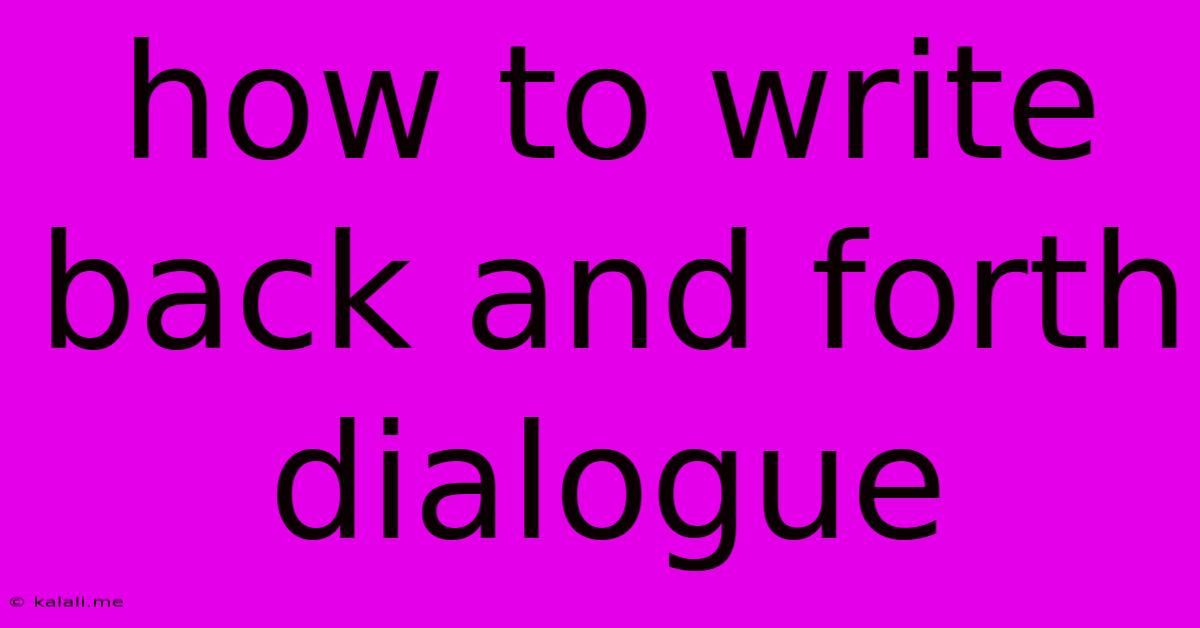How To Write Back And Forth Dialogue
Kalali
Jun 08, 2025 · 3 min read

Table of Contents
How to Write Back-and-Forth Dialogue That Pops
Writing realistic and engaging dialogue is crucial for any narrative, whether it's a novel, screenplay, or even a short story. Back-and-forth dialogue, in particular, can be challenging. It's easy to fall into repetitive patterns or create conversations that feel unnatural. This guide will help you craft dynamic and captivating dialogue that keeps your readers hooked. Mastering this skill will significantly enhance your storytelling and boost your SEO by making your content more engaging and shareable.
Why is good dialogue so important? Engaging dialogue breathes life into your characters, propels the plot forward, reveals character personalities and relationships, and keeps readers turning the page. Poor dialogue, on the other hand, can feel stilted, unnatural, and even jarring, pulling readers out of the story.
Understanding the Fundamentals of Back-and-Forth Dialogue
Before diving into specific techniques, let's establish a solid foundation. Good back-and-forth dialogue is more than just two people exchanging lines. It's a dance of words, a dynamic exchange that reveals:
- Character voice: Each character should have a unique way of speaking, reflecting their personality, background, and education.
- Subtext: What's not said can be just as important as what is said. Subtext adds layers of meaning and complexity to the conversation.
- Conflict and tension: Dialogue should often create conflict or tension, even subtly, to keep the reader engaged.
- Plot progression: The conversation should contribute to the overall narrative, revealing information, advancing the plot, or creating conflict.
Techniques for Crafting Compelling Back-and-Forth Dialogue
Here are some key techniques to elevate your dialogue writing:
1. Vary Sentence Structure and Length: Avoid monotonous patterns. Mix short, punchy sentences with longer, more descriptive ones. This mirrors real-life conversation, which isn't always neatly structured.
2. Incorporate Action and Description: Don't just focus on the words being exchanged. Include actions and descriptions to bring the scene to life. For example: "Sarah slammed her fist on the table. 'I've had enough!' she shouted." This adds visual interest and context.
3. Use Subtext Effectively: Hint at underlying emotions or motivations without explicitly stating them. This allows readers to infer meaning and become more invested in the characters. For instance, a character might say "I'm fine," but their body language contradicts this statement, hinting at underlying stress or unhappiness.
4. Avoid Info-Dumping: Don't use dialogue solely to deliver exposition. Instead, weave information naturally into the conversation. Think of how people naturally share information within a conversation, not in a single, long monologue.
5. Show, Don't Tell: Use dialogue to reveal character traits and relationships rather than simply stating them. For example, instead of saying "John is angry," show him slamming doors and raising his voice.
6. Use Dialogue Tags Sparingly: Overuse of dialogue tags like "he said," "she replied," can interrupt the flow. Vary your tags or eliminate them altogether when the context is clear. Focus on strong verbs to convey the emotion behind the words. For example, instead of "He said angrily," try "He snarled."
7. Listen to Real Conversations: Pay attention to how people actually talk. Observe the pauses, interruptions, and overlapping speech that occur in real-life interactions. This will help you create more realistic and engaging dialogue.
8. Read Widely: Analyze the dialogue in your favorite books and scripts. Pay attention to how successful authors create engaging and believable conversations.
Editing and Refining Your Dialogue
Once you've drafted your dialogue, it's crucial to revise and refine it:
- Read aloud: This helps identify awkward phrasing or unnatural rhythms.
- Seek feedback: Ask a friend or beta reader to review your work and provide constructive criticism.
- Cut unnecessary words: Conciseness is key. Remove any dialogue that doesn't serve a purpose.
- Ensure consistency: Maintain consistency in your character's voices throughout the narrative.
By applying these techniques, you can craft back-and-forth dialogue that not only propels your story forward but also captivates your readers and leaves a lasting impact. Remember, practice makes perfect! The more you write, the better you'll become at creating realistic and engaging dialogue.
Latest Posts
Latest Posts
-
How To Remove Scuff Marks On A Car
Jun 08, 2025
-
How Long Can Chicken Be Left Out
Jun 08, 2025
-
Why Did Aquaman Kill Black Mantas Father
Jun 08, 2025
-
Seurat Percentage Of The Largest Gene Expression
Jun 08, 2025
-
Saints Row Iv Re Elected Cheats
Jun 08, 2025
Related Post
Thank you for visiting our website which covers about How To Write Back And Forth Dialogue . We hope the information provided has been useful to you. Feel free to contact us if you have any questions or need further assistance. See you next time and don't miss to bookmark.